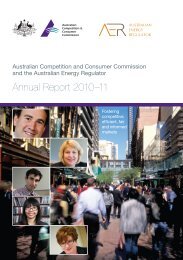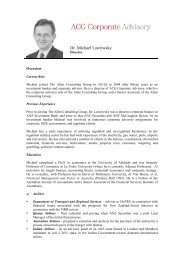Transend - Appendix 5 Renewal capital expenditure - Australian ...
Transend - Appendix 5 Renewal capital expenditure - Australian ...
Transend - Appendix 5 Renewal capital expenditure - Australian ...
Create successful ePaper yourself
Turn your PDF publications into a flip-book with our unique Google optimized e-Paper software.
0BInvestment Evaluation Summary<br />
TNM-GS-809-0720<br />
This option would not satisfy the investment needs and compliance issues outlined in sections 3 and 4 of this paper. In<br />
addition, it would not align with the strategies detailed in the ‘EHV Bus Bar Protection Asset Management Plan’ (TNM-<br />
PL-809-0702) and would not be consistent with good electricity industry practice.<br />
Maintaining the existing bus bar protection schemes presents the significant risk of failures impacting on the operation of<br />
the transmission network. The 110 kV and 220 kV bus zone protection schemes present an imminent risk that an<br />
extended failure will result in the significant constraint of power flow through the substation.<br />
7.2- REPLACE THE BUS BAR PROTECTION SCHEMES WITH SINGLE SCHEMES<br />
AND DEFER PROVISION OF DUPLICATE SCHEMES<br />
This option comprises the replacement of the 110 kV and 220 kV bus bar protection schemes with single schemes and<br />
then installing the duplicate schemes in 2016.<br />
This option would address the performance issues associated with the bus bar protection schemes in the short term, but it<br />
would not provide any benefits when the new bus bar protection schemes are out of service because generation will still<br />
be constrained. In addition, the non-compliance issues identified in section 4 of this paper would continue to remain<br />
largely unresolved. Although the new bus bar protection schemes will be more reliable and require less maintenance than<br />
the existing schemes, outages will still be required while maintenance or modifications to the schemes are being<br />
undertaken, until the duplicated schemes were installed in 2016.<br />
7.3- REPLACE THE BUS BAR PROTECTION SCHEMES WITH DUPLICATE<br />
SCHEMES<br />
This option comprises the replacement of the 110 kV and 220 kV bus bar protection schemes with new, duplicated<br />
protection schemes.<br />
This option would satisfy all of the investment needs and compliance issues outlined in sections 3 and 4 of this paper and<br />
would provide all of the benefits identified in section 6. In particular, the installation of duplicate bus bar protection<br />
schemes will ensure that Farrell Substation 110 kV and 220 kV continues to meet the requirements of the NER during<br />
outages of either bus bar protection scheme. The duplication of bus bar protection also enables the planned and<br />
unplanned maintenance to be conducted on one of the schemes without the need to rely on back-up distance protection<br />
schemes. As detailed in section 3 of this paper distance protection can not be guaranteed to respond to bus bar faults, and<br />
when they do it will be in a delayed clearance, potentially to the detriment of power system security.<br />
Bus bar protection scheme outages will required when primary or secondary systems associated with a substation bay are<br />
upgraded or replaced. The replacement of a number of transmission line and transformer protection schemes at Farrell<br />
Substation is planned over the next five years. The installation of duplicate bus bar protection schemes will enable these<br />
works to proceed whilst maintaining one of the A or B schemes in service at all times.<br />
In addition, this option is consistent with the strategies detailed in the ‘EHV Bus Bar Protection Asset Management Plan’<br />
(TNM-PL-809-0702) and is consistent with good electricity industry practice.<br />
8. OPTION ESTIMATES<br />
A detailed net present value (NPV) analysis has been undertaken for each of the options considered. The NPV analysis<br />
takes into account initial and future <strong>capital</strong> <strong>expenditure</strong>, ongoing operations and maintenance costs, unserved energy<br />
costs and estimated costs associated with the loss of generation capacity. A summary of the NPV cost analysis for the<br />
options considered is presented in Table 3.<br />
© <strong>Transend</strong> Networks Pty Ltd 9 of 10







